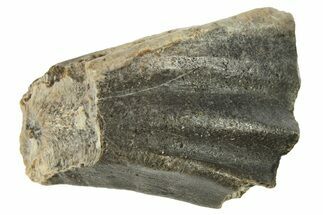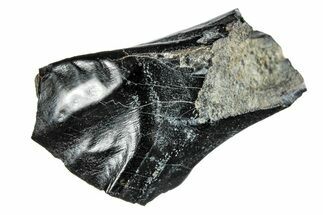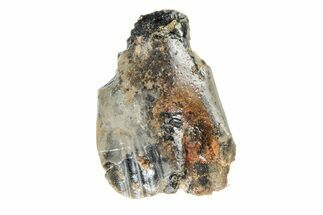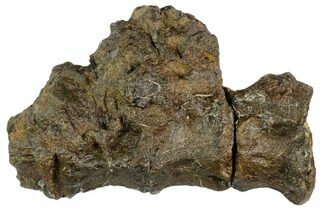This Specimen has been sold.
.92" Fossil Abelisaurid Dinosaur (Kryptops) Tooth - Niger
This is a .92" long tooth of an abelisaurid dinosaur (Kryptops palaios). It comes from the Early Cretaceous-aged (Albian Stage) Elrhaz Formation of Gadoufaoua, Niger.
Comes with a riker mount display case.
The serrations are worn along both edges.
Comes with a riker mount display case.
The serrations are worn along both edges.
Kryptops palaios is a species of abelisaurid theropod that lived in what is now Niger during the Early Cretaceous, and the earliest known abelisurid. It is described from a single partial skeleton found in Niger's Elrhaz Formation lagerstätte in what is now the Ténéré desert region. The partial skeleton consists of a heavily textured maxilla, vertebrae, ribs, and an articulated pelvic girdle and sacrum. However, the post-cranial remains were found about 15 meters away from the maxilla, so some paleontologists consider the skeleton to be a chimera.
K. palaios's maxilla was found unusually textured, covered in pits and blood vessel impressions. This has led paleonologists to believe that the theropod had a facial covering, likely made of keratin, firmly attached to its face.
K. palaios's maxilla was found unusually textured, covered in pits and blood vessel impressions. This has led paleonologists to believe that the theropod had a facial covering, likely made of keratin, firmly attached to its face.
The Elrhaz formation is an Early Cretaceous fossil formation dating 112-125 million years ago in the Tenere Desert of northeastern Niger. It is mainly known to paleontologists for the Gadoufaoua site, a large fossil deposition painting a picture of the ecology of a wet, green, riverine environment.
The dinosaurs that called this region home include the sail-backed hadrosauriform Ouranosaurus, an herbivore which reached about 28 feet and 2 tons. Nigersaurus, a mid-sized sauropod with a horizontal mouth arranged with dozens of peg-like mowing teeth, would have grazed upon the bounty of greenery in herds that trailed across the landscape. In turn, these large herbivores were hunted by equally large predators.
Eocarcharia was a smaller sized African Carcharodontosaurid, only 20-25 feet long compared to its larger, 40-foot cousins like Giganotosaurus and Carcharodontosaurus. Still, Carcharodontosaurids were formidable predators, hunting with laterally compressed, highly effective cutting teeth. Alongside them were the slightly smaller abelisaurid predator Kryptops. Reaching about 20-23 feet, Kryptops likely used hit and run tactics to wear out prey animals, as opposed to the withering bites delivered by the larger Eocarcharia.
By far the largest predator in the formation, however, was the spinosaurid theropod Suchomimus. Meaning "Crocodile Mimic" for its superficially crocodilian appearance, Suchomimus cleared its competitors' size by a good 10 feet, usually in the realm of 30-35 feet in length and weighing 4 tons. Suchomimus was likely more of a generalist than its spinosaurid cousins. Its body was more suited to wading than to diving. Meanwhile, its size likely made it more than capable of preying on both fish in shallow water and any unfortunate small to mid-sized dinosaurs it may come across.
Notable non-dinosaur fauna from the formation include the super sized Sarcosuchus, a huge crocodylomorph that reached lengths exceeding 30 feet. Other crocodile relatives include the ratlike Araripesuchus, and the broad duck-snouted Anatosuchus. Several fishes called the region their home as well, such as the massive 10- to 15-foot long coelacanth species Mawsonia, and the shark Hybodus.
The dinosaurs that called this region home include the sail-backed hadrosauriform Ouranosaurus, an herbivore which reached about 28 feet and 2 tons. Nigersaurus, a mid-sized sauropod with a horizontal mouth arranged with dozens of peg-like mowing teeth, would have grazed upon the bounty of greenery in herds that trailed across the landscape. In turn, these large herbivores were hunted by equally large predators.
Eocarcharia was a smaller sized African Carcharodontosaurid, only 20-25 feet long compared to its larger, 40-foot cousins like Giganotosaurus and Carcharodontosaurus. Still, Carcharodontosaurids were formidable predators, hunting with laterally compressed, highly effective cutting teeth. Alongside them were the slightly smaller abelisaurid predator Kryptops. Reaching about 20-23 feet, Kryptops likely used hit and run tactics to wear out prey animals, as opposed to the withering bites delivered by the larger Eocarcharia.
By far the largest predator in the formation, however, was the spinosaurid theropod Suchomimus. Meaning "Crocodile Mimic" for its superficially crocodilian appearance, Suchomimus cleared its competitors' size by a good 10 feet, usually in the realm of 30-35 feet in length and weighing 4 tons. Suchomimus was likely more of a generalist than its spinosaurid cousins. Its body was more suited to wading than to diving. Meanwhile, its size likely made it more than capable of preying on both fish in shallow water and any unfortunate small to mid-sized dinosaurs it may come across.
Notable non-dinosaur fauna from the formation include the super sized Sarcosuchus, a huge crocodylomorph that reached lengths exceeding 30 feet. Other crocodile relatives include the ratlike Araripesuchus, and the broad duck-snouted Anatosuchus. Several fishes called the region their home as well, such as the massive 10- to 15-foot long coelacanth species Mawsonia, and the shark Hybodus.
SPECIES
Kryptops palaios
LOCATION
Gadoufaoua, Téneré Desert, Niger
FORMATION
Elrhaz Formation
SIZE
.92" long
CATEGORY
SUB CATEGORY
ITEM
#283926
We guarantee the authenticity of all of our specimens.
 Reviews
Reviews












